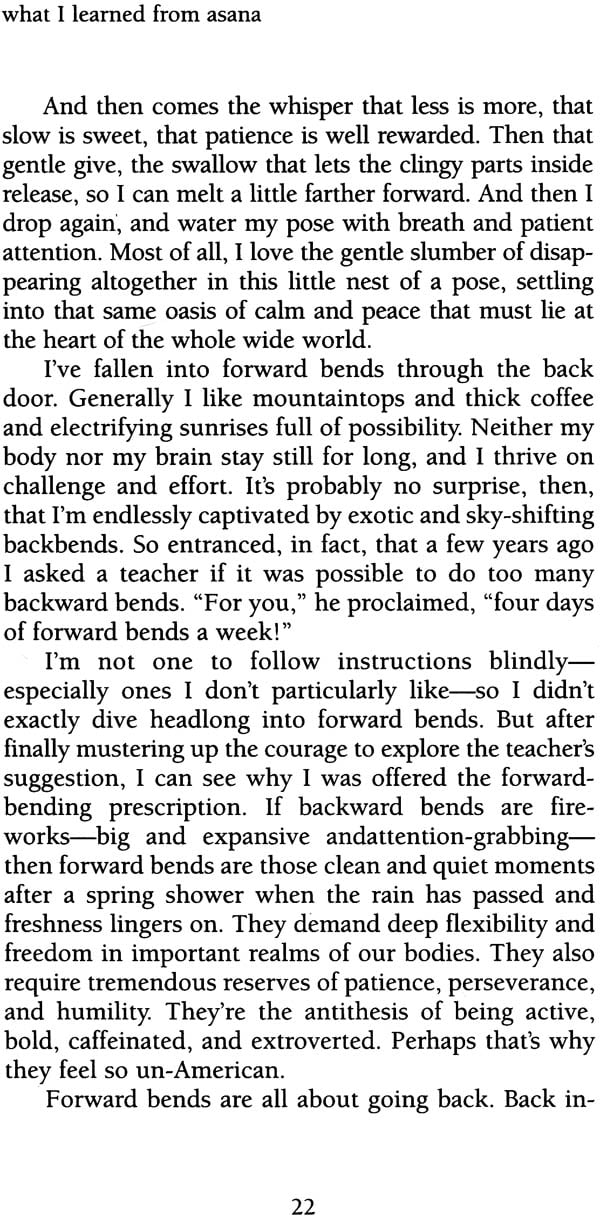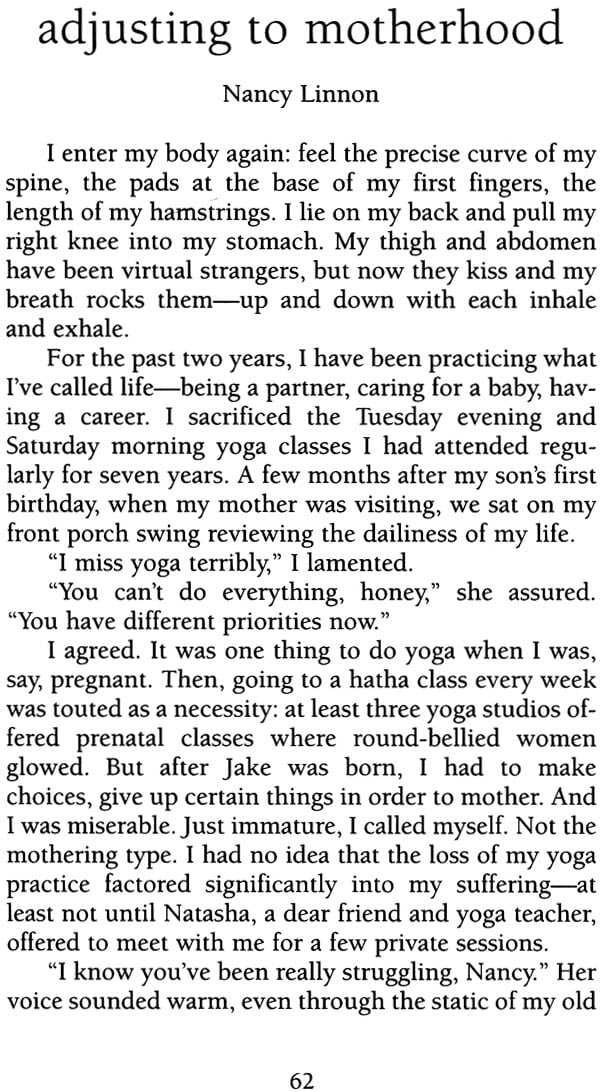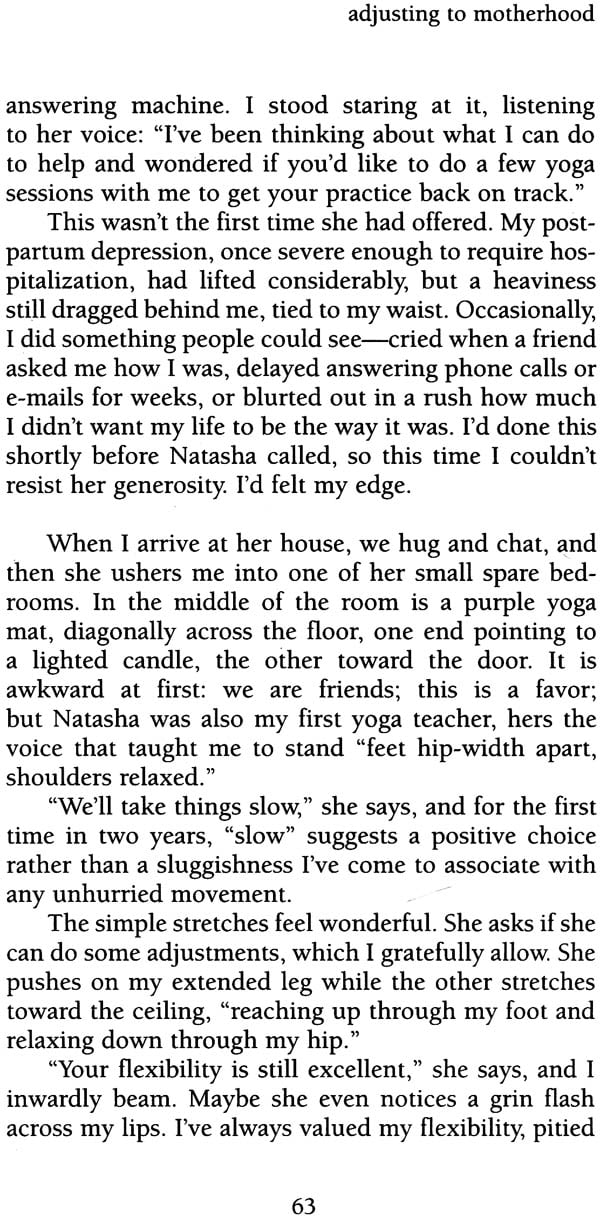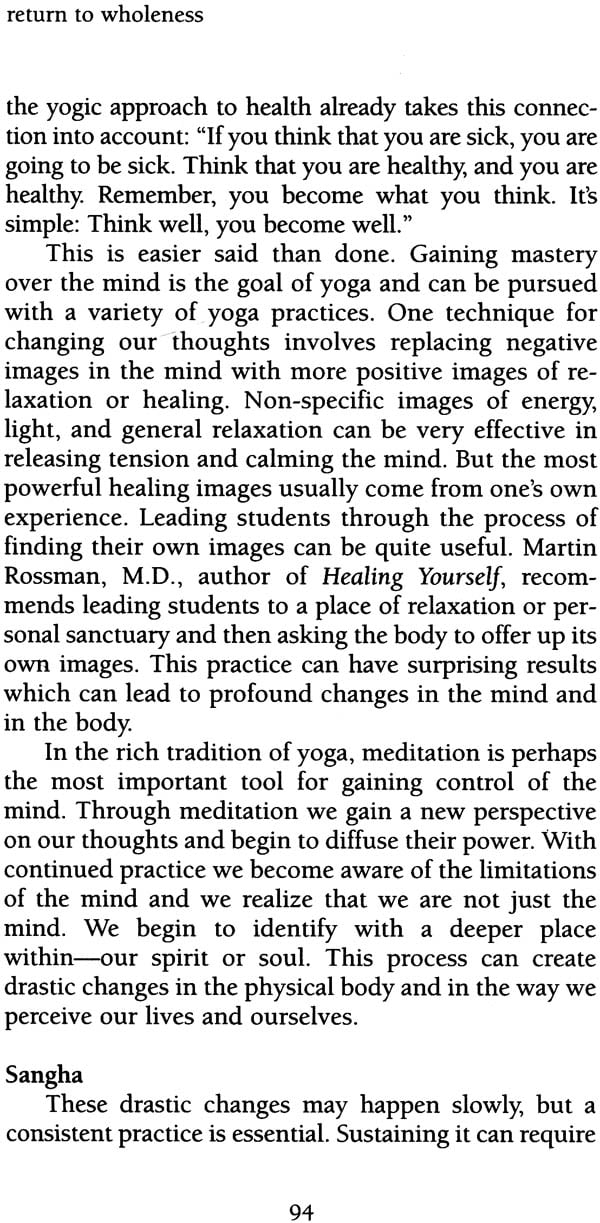
Spirit On The Move (Personal Essays on Yoga in Daily Life)
Book Specification
| Item Code: | NAG201 |
| Author: | Linda Johnsen |
| Publisher: | Himalayan Institute |
| Language: | English |
| Edition: | 2005 |
| ISBN: | 9780893892449 |
| Pages: | 143 |
| Cover: | Paperback |
| Other Details | 8.5 inch X 5.5 inch |
| Weight | 260 gm |
Book Description
About the Book
"Mention the word 'Yoga' and most Americans imagine a little young woman leaning so far backward that she can touch the floor behind her with her fingertips." Thus begins Linda Johnsen's introduction to this engaging and often profound book. Unsurprisingly, she goes on to explain that yoga is far, far more than the hatha postures seen by the casual observer. Yoga is a way of life, and its lessons are seemingly without number.
Spirit on the Move is a collection of personal essays, first published in Yoga International magazine, that express the variety of riches found along the path of yoga. Some essays are light and humorous, while others are deeply thoughtful and spiritual. One writer describes how yoga has helped him face his own mortally. Another chronicles her yoga-inspired journey out of "chocolate addiction." Still another confesses her past as a "yoga snob" who saw wealth and authenticity as incompatible.
What will you learn from the first-hand accounts of this diverse group of contributors? Certainly you'll emerge from this book with a newfound appreciation for what yoga really is. But more to the point, you'll gain insights of your own: how what you learn in yoga class translates into your daily interactions with others how to move gracefully and skillfully through all that life brings you and how to never forget the real purpose of your journey here on earth.
Introduction
Mention the word "yoga" and most Americans imagine a lithe young woman leaning so far backward she can touch the floor behind her with her fingertips. Yoga has become virtually synonymous with hatha postures in the West. Ask mediators, though, what "yoga" is, and many of them will immediately think of the famous verse from the Yoga Sutra that says, "Yoga means control of the movements of the mind." They'll imagine a sage sitting motionless in higher states of consciousness.
So it's a surprise to open up one of the most important classics on yoga ever written, the Bhagavad Gita, and find yet another definition. In this amazing book, the yoga master Krishna Vasudeva says instead, "Yoga is skill in action." What was he talking about? Krishna knew full well that sages don't just sit; they get up off their meditation seats and serve the world. They're well aware that if they bring their inner life into their outer life, practicing meditation in motion, their service is likely to be far more efficient and effective.
Krishna was himself a living example of the application of expanded awareness in the practical affairs of real life. He was a prince who ruled in northeastern India five thousand years ago. He married, raised children, distinguished himself in politics and war, and enjoyed many of the luxuries that life in the surprisingly advanced Indian culture of that era had to offer. He was no ascetic tucked away in a remote Himalayan cave; on the contrary, he was the good-looking son of Indian royalty, well known for his romances. Yet his extraordinary insight and his unfailing willingness and ability to help those in trouble are still legendary today, many, many centuries after his death. He wasn't just skilled in yoga. He was skilled in life.
If asanas (yoga poses) and maybe some meditation are the vehicle for our spiritual efforts, then daily life is where the rubber hits the road. Traditional yoga always leaves us feeling relaxed, centered, and alert. We feel healthier, more balanced, and more alive in a delightfully unagitated way. But do the peace and clarity we experience during our yoga sessions transmit themselves into our family life, our dealings with a hostile supervisor, shopping at the mall, or recovering from the flu? If we've done our yoga au thematically, and we're living our lives with full attention, we uncover new levels of skill in action, of the capacity to do what we normally do but doing it better, of the ability to respond calmly, appropriately, and perhaps even brilliantly to crises.
Yoga teachers never tire of explaining to new students that the word "yoga" means "union." But union with what? Union with everything. Union with our body during our hatha routine, a body from which ironically many of us spend much of our lives mentally disconnected. ("I have high blood pressure? When did that happen?") Union with our inner guidance, called buddhi in the yoga tradition, which prompts us to act wisely even when wisdom doesn't instantly gratify. ("No, I'll pass on that second drink. Thanks anyway!") Union with every other living being in the universe. ("The sage sees the Self in all beings and all beings in the Self. Therefore he loves everyone," says that most mystical of yoga texts, the Isha Upanishad.)
But yoga is most fundamentally about union with our Self, with the living, healing, creative consciousness at the root of our being. When we "hook up" with this perfectly still, perfectly dynamic awareness that shines non-stop beyond our body, behind our emotions, underneath our thoughts, we experience an astonishing side effect: skill in action. We become focused and productive. We behave ethically without external prompting. Confusion evaporates. The path ahead becomes clear. We understand what we need to do and do it well!
Classical yoga (also known as raja yoga), the tradition outlined by Patanjali in his Yoga Sutra, steers us through eight stages from the outside in. First, of course, we learn how not to behave (don't harm others or yourself, don't be dishonest, don't take what isn't yours, don't overindulge, don't be greedy). Second, we learn how we should behave (be clean, be content, be self-disciplined, look into the nature of things, and have faith in a higher force). Third, we learn to sit still in a steady but comfortable posture. Fourth, we gently regulate our breathing pattern to optimize our state of tranquil alertness. Fifth, we pull our attention out of the room around us, out of our body, even out of our thoughts and feelings, memories and fantasies, and anchor our awareness in itself.
Sixth, we contemplate an image or idea with our full attention. Seventh, we meditate, focusing our awareness with laser-like intensity on one object, such as a mantra, without any distraction. Eighth, we enter a higher state of consciousness in which the distinction between ourselves and the object we're focused on vanishes. We now literally experience "yoga" or union with it. If the object we've chosen is our own innermost Self, in that moment of crystalline clarity we become most fully what we really are the light of pure awareness itself.
Other yoga classics like the Tripura Rahasya and the Yoga Vasishtha direct us back from that innermost experience into the outer world. After all, we still need to eat. We still have to get the kids off to school in the morning, show up for work, and catch that new movie we've been wanting to see. As Krishna points out in the Bhagavad Gita, even the greatest yogis can't sit in meditation all the time. But we can bring the clarity and understanding of meditation with us into our external activities. Then we start to live less like victims and more like enlightened beings. We start practicing skill in action.
"Skillful Action" is the name of a column in Yoga International magazine in which practitioners share their insights and experiences on the path of yoga. All of the selections in this book first appeared there. We hear from teachers and students, people facing illness and people recovering, new mothers and old souls. We learn what they learned from their yoga practice, from nature, and from life. We watch as they pull it all together in a culture that doesn't particularly value spiritual exploration. Discovering what they discovered fuels our journey. We're on this road together, and the horizon keeps getting brighter. Skill in action is yoga from the inside out. It's spirit on the move, the soul expressing itself more elegantly than we ever imagined possible. It's us fulfilling our purpose for being in a body. It's the greatest, most amazing adventure.
Contents
| Introduction | vii |
| What I learned from asana | |
| Moving from the Heart | 2 |
| Ahimsa in action | 5 |
| Opening to the sun | 11 |
| Illusions of the perfect pose | 17 |
| Falling forward | 21 |
| The art of Surrender | 27 |
| The Natural World | |
| A fish story | 37 |
| How to grow a gardener | 41 |
| The disappearing Urban Dweller | 47 |
| Facing mortality | 50 |
| Return to wholeness | |
| The benefits of bad health | 57 |
| Adjusting to motherhood | 62 |
| At home in my body | 69 |
| Healing from abuse | 73 |
| Yoga for diabetics | 77 |
| My encounter with breast cancer | 84 |
| Illness as a teacher: HIV and AIDS | 91 |
| Yoga in a material culture | |
| Grappling with greed | 99 |
| Chucking chocolate | 103 |
| Feeding the monkey mind | 109 |
| Confessions of a Yoga Snob | 115 |
| Yoga for sale | 119 |
| Yoga in a spiritual culture | 127 |
| Contributors | 131 |













